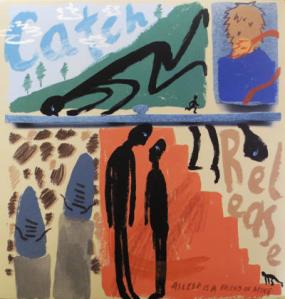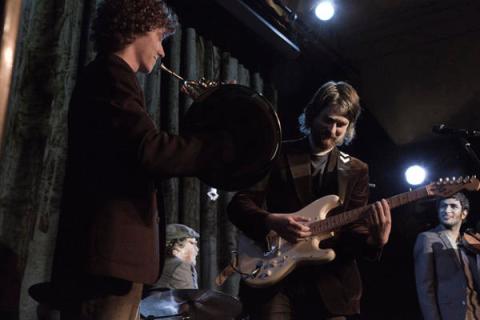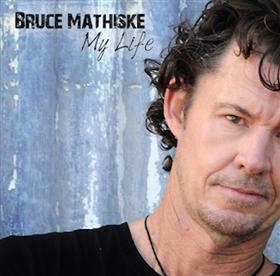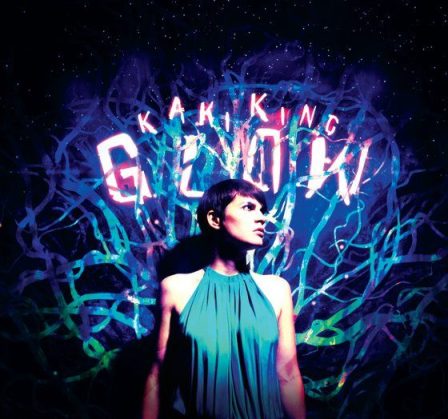Firmly established in its 24th year as one of the premier music festivals of the world, the Byron Bay Bluesfest continues to top its already heady highs. The lineup for this year’s festival was a dream program for lovers of blues and roots music and anything else festival director Peter Noble decided to throw our way.
Criticised in the past for veering too far from its original blues brief, Bluesfest has outgrown these criticisms purely by booking the biggest acts in the world, and some of the most interesting – over the past few years headliners have been Bob Dylan, B B King, Crosby, Stills & Nash, Yes, Creedence Clearwater Revival’s John Fogerty, Paul Simon and (almost) Roger Daltrey performing Tommy (even though Daltrey didn’t show – next year maybe?).
Noble’s knack for picking the greats, blues or not – and a demonstration of the power he wields on the world festival circuit in doing so – was vindicated by this year’s record attendance: capacity crowds of 17,000 per day which adds up to 85,000 in toto.
And I was one of those fools dancing in the rain. And the smile is still on my face.
__________________________________________________________
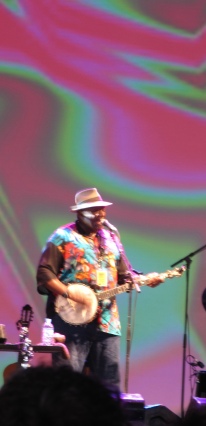
Taj Mahal
Accompanied by Gaz T, my intrepid local tracker and native guide, my 24th Byron Bay Bluesfest experience started on the Friday with the wonderful Taj Mahal. Mahal was one of those bluesmen – like Sonny Terry and Brownie McGee – that the 1970s hippie freaks took to their hearts back in those fragrant days. His popularity has remained undiminished since then. As is often the case, I expected a creaky veteran, tottering on a chair – but what we got was a big man, standing tall, whipping his trio through modern blues, pre-war country blues and even calypso flavoured blues. Yeah!
And if Taj Mahal surprised me with his age-denying vigour, reggae and ska legend Jimmy Cliff utterly floored me. Cliff was already a star in Jamaica while Bob Marley was merely learning his trade, and at 65 he has lost nothing – twisting, dancing, leaping through his set. It is this pin-sharp showmanship that reminds us of the huge influence classic 60s Motown had on pre-Marley Jamaican artists. Slick, soulful and bang-on, his beautiful songs had heart, message and groove.
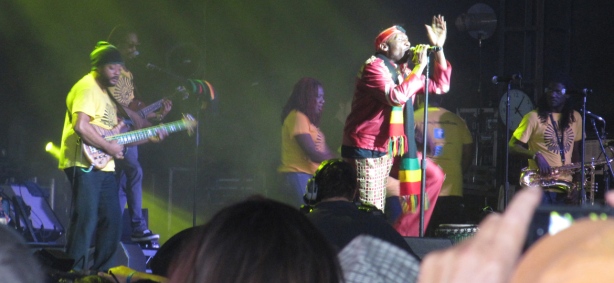
Jimmy Cliff

Shuggie Otis
While everyone headed to Steve Miller in one of the big tents, I moved towards the smaller Jambalaya stage and blues guitarist Shuggie Otis. Otis was a child prodigy of the blues guitar, the son of rhythm-and-blues bandleader Johnny Otis. After a few semi-hits in the 70s he faded from view. After a 40 year hiatus for whatever reason, he is back touring the world and I could not miss him. Rail thin and now with the angular almost-Latin good looks of his father, Shuggie seemed troubled and ill at ease. But when he found his zone and soared, he soared higher and higher. His beautiful playing took my breath completely away. In a way it was more exciting to see an artist who could easily miss, but hit it so well; compared to all the other in-the-pocket coolly-pro bands at Bluesfest, Otis’s set had that element of danger. Sublime and edgy.
Then the rain hit and my Bluesfest experience sprung a leak. Not having brought a raincoat or wet-weather gear I was soaked to the skin in minutes. Not being able to squeeze into the Steve Miller tent I stood in the rain and watched him play ‘Fly Like An Eagle’ – rain will come and go, the beautiful epoch-defining voice of The Space Cowboy (some call him Maurice…) singing this glorious freedom song was here and now. Around me, teenage fans danced in the rain to Miller’s golden period hits, singing every word to ‘Rockin’ Me Baby’ and ‘The Joker’. It’s only rain, it can soak our skin but it can’t dampen our spirit.
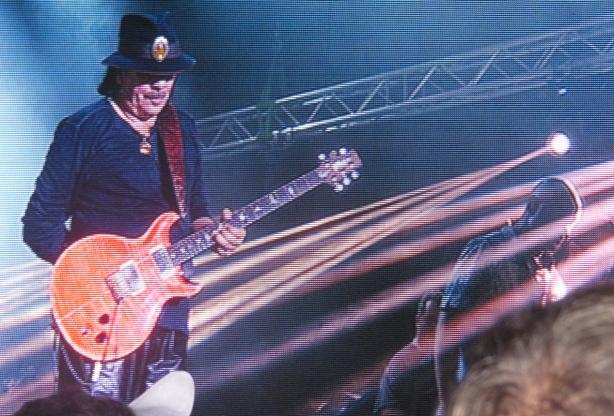
Carlos Santana
Keeping the San Fran psychedelic vibe going – albeit in a very very different way – Santana’s set began with cosmic interstellar graphics fading in and out of the two huge screens either side of the stage. Then it was a brief drum roll from drummer Dennis Chambers and the Santana band roared into 1971’s ‘Toussaint L’Overture’. As well as Chambers, the percussion backline was made up of long-time conguero Raul Rekow and Karl Perazza on timbales – who together propelled the music like a freight-train, but a freight-train which skips and dances lightly along the track. Of course the main voice of this band has always been the elegant guitar playing of Carlos Santana – always lyrical, always going for the emotional connection over the empty dazzle of technique. Which ultimately makes him, above and beyond his Latin and jazz phrasing, one hell of a great blues guitarist – as we heard from a short (and all too rare) snatch of Santana playing some straight blues during the set. Can music reviewers still use words like ‘celestial’? I guess I just did, because it is the only word I have left to describe Santana’s unearthly performance.
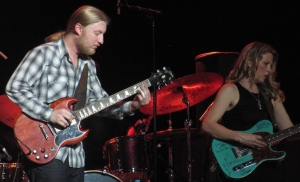
Derek Trucks and Susan Tedeschi
The day ended with a truly soulful set from The Tedeschi-Trucks Band. The absolute highlight of my first ‘Fest two years ago, the band of slide ex-wünderkind Derek Trucks and his wife, vocalist Susan Tedeschi never fails to amaze. For their 2013 return they brought their three-man horn section along and their firepower went up a notch. The thrilling ‘Midnight In Harlem’ – a song that is built on an almost sexual upward curve – had Trucks’ solo coda taking it up and up into that region that Carlos Santana used to (and I am sure still does) call ‘spiritual orgasm’.
I was saturated with rain, good vibes and killer music. And I still had two days to go.
________________________________
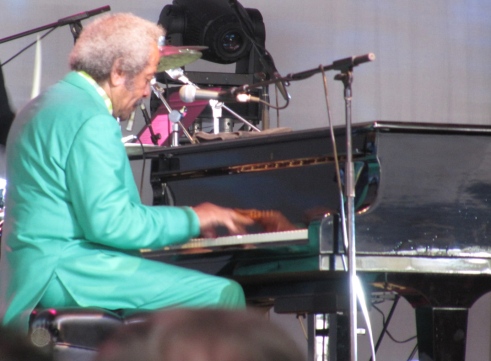
Allen Toussaint
Saturday we eased in with the once and future king of the Big Easy himself, New Orleans magus Allen Toussaint. The man’s CV is virtually a history of modern R&B, soul and funk and his urbane cool belies his immense impact in shaping these musics. As if his beautiful, artfully funky music (and stunningly virtuosic piano playing) wasn’t gift enough, he threw Mardi Gras masks (and green and yellow AFL footballs?) to the crowd. A charmer in every way.
After a while cruising the human river and people watching (a Bluesfest pastime in itself) I chanced upon Jeff Tweedy and Wilco. And it was one of those wonderful music moments when seeing a band live makes you an instant fan – all subsequent listening experiences filtered through that thrilling ‘Eureka!’ moment of discovery. Wilco’s music seems to beat with the same American-classic heart at the centre of the songs of Neil Young and the darker Bruce Springsteen material. The band (especially guitarist Nels Cline) seem to be able to paint perfect soundscapes behind any of Tweedy’s songs, be they dark rockers or sweeter country-tinged ballads. A revelation.
Floating on the beauty of Wilco’s music I was yanked back down to earth by Status Quo. Britain’s answer to AC/DC, the indestructible Quo have been playing the same song for over 40 years – a variant on 12-bar pub boogie that has sold 118 million albums (think about that figure for a minute). Watching their flawless set, with mainstays Francis Rossi and Rick Parfitt rocking hard before banks of white Marshalls, I could (almost) forgive them their awful Coles ads. Some bands are simply a force of nature and Quo are a blast of the simple joy of undiluted rock’n’roll.
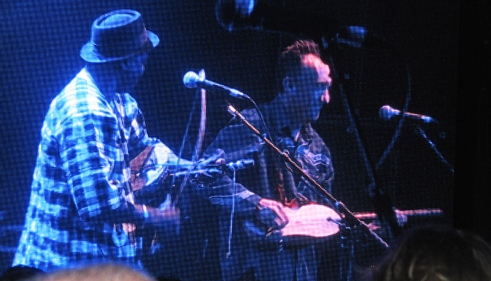
Robert Plant’s Sensational Shape Shifters
The straight-from-the-botttle thrust of Quo was perhaps a good brain-scourer – an astringent appetiser – for the almost too-rich feast that was Robert Plant, which followed next. The fabled Led Zeppelin vocalist has been the main obstacle to any Led Zep reunions, as he has always moved forward with his music, taking his former band’s world-music aesthetic to greater heights than they ever did. His new band, The Sensational Shape Shifters, are the best version of Plant’s patented future-primitive groove – to one side of the stage we have Juldeh Camara working a Gambian wooden banjo, to the other side keyboardist John Baggott (ex-Massive Attack) sits in a nest of synths and laptops. Plant acknowledged the faithful with a few Led Zeppelin tunes, but messed with their anthem ‘Whole Lotta Love’, bedding it in a chugging African drum figure. Unlike almost every other ‘legendary’ act at Bluesfest he made no attempt to recreate his past, instead giving us a show we would think about for many months to come – a show driven by the restless creativity and often contrary nature of a true and uncompromising artist.
________________________________
Sunday we awoke to clouds and gray skies over the succulent green of Byron Shire. At the ‘Fest, Tony Joe White’s Swamp-Fox baritone conspired with the dull skies to lull us into maybe too deep a state of ‘relaxation’. We needed a wake-up!
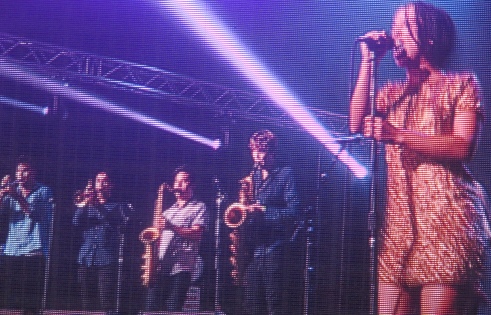
Saskwatch
And we got it in the shape of Melbourne nine-piece Saskwatch. Bursting with chops and youth – and fronted by their not-so-secret weapon, vocalist Nkechi Anele – the band mixes soul, funk and Afrobeat horns to great effect. Like Mayer Hawthorne in the US they also take the bouncier, pop-soul side of Motown and do great things with it. Last year it was The Eagle and The Worm that assured me music is in good hands for the future – this year is was the snap, crackle and (soul-)pop of Saskwatch.
My 2013 Bluesfest experience wound to a finish in a mix of rain, muddy dancers and 1970s progressive rock classicism. Jon Anderson, the vocalist of perhaps the greatest of all Prog bands, YES, played an intimate solo show for us that was quite sublime. (Oddly, YES played Bluesfest last year with –surreally – a replacement vocalist who was drawn from a YES covers band). Listening to Anderson peppering his set with acoustic, folky versions of YESsongs made me realise that it was in this form these tunes were written and presented to the band – who then proceeded to inflate them to Prog size. Unadorned with pomp, they are lovely songs, Anderson’s voice is one of the sweetest in all Rock and the man is once of our most beloved space cadets.
My prize for 24th Bluesfest Festival Moment goes, however, to the experience of standing in the teeming rain, with my 5 dollar poncho disintegrating on my back as I listened to Supertramp’s Roger Hodgson singing ‘It’s Raining Again’ (with not a drop of irony from what I could gather). But of course, the magic of his songs – one beautifully uplifting hit after another – sung in his spacey tenor blew away the rainclouds in my head and warmed the souls of all who listened. Once again, it’s only rain; this was bliss, a good reason to live right here, right now.
_______________________________________
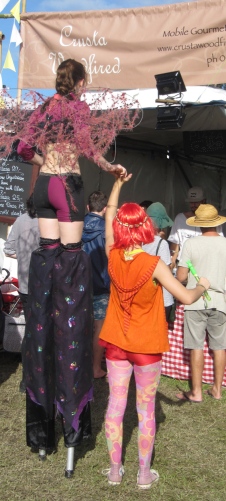
Beautiful people
So that was it – right there, right then. Bluesfest 2013 – a festival beyond belief in so many ways. Criticisms? Around me I heard faint grumbles of over-selling and over crowding, and yes, it seemed fuller that previous years. But it is never anything like a problem – considering the logistics of an event that has grown to such proportions, artistically and attendance-wise.
What will Peter Noble conjure up for us next year? Being the 25th Bluesfest, he and his intrepid team will need to go beyond the pale to top the jaw-dropping line-ups of the last few years. The Jimi Hendrix Experience? The Beatles? Elvis Presley (pre-Hollywood of course)? I am just putting it out there – and knowing Noble’s almost supernatural powers (coupled with the soul of a true music fan), I really wouldn’t entirely put it past him.
Published April 2013 on megaphoneoz.com
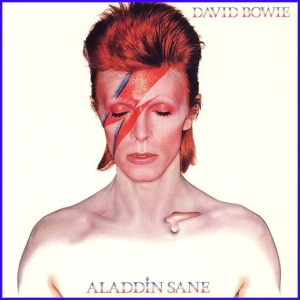
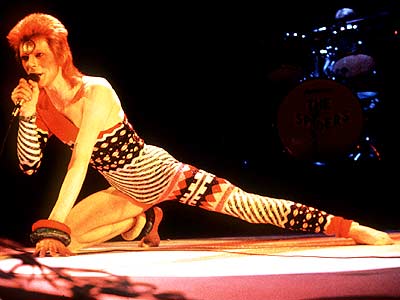 Then there’s Mick Ronson’s volcanic Les Paul intro to ‘Cracked Actor’ and the cartoon Berlin cabaret of ‘Time’ – ‘Time/He flexes like a whore/Falls wanking to the floor…’, the fuck-off arrogant cover of the Stones ‘Let’s Spend the Night Together’ and the nightmare doo-wop of ‘Drive In Saturday’. Bowie tested his fans with some wild creative lunges, and yet, batting at the top of his game, rarely misfired.
Then there’s Mick Ronson’s volcanic Les Paul intro to ‘Cracked Actor’ and the cartoon Berlin cabaret of ‘Time’ – ‘Time/He flexes like a whore/Falls wanking to the floor…’, the fuck-off arrogant cover of the Stones ‘Let’s Spend the Night Together’ and the nightmare doo-wop of ‘Drive In Saturday’. Bowie tested his fans with some wild creative lunges, and yet, batting at the top of his game, rarely misfired.








